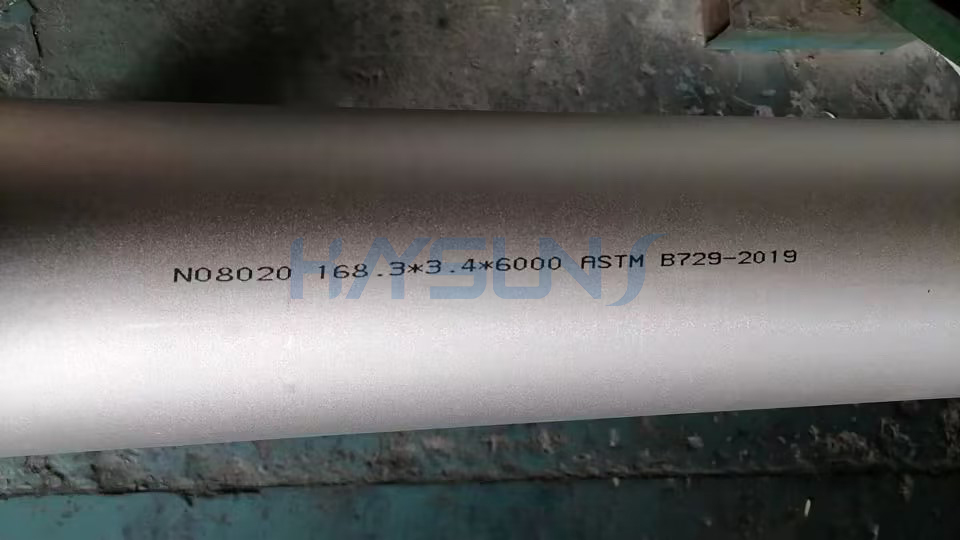What is Duplex steel 2205
Duplex Stainless Steel (DSS) refers to about 50% of ferrite and austenite, and generally requires less than 30% of stainless steel. In the case of low carbon content, the Cr content is between 18% and 28%, and the Ni content is between 3% and 10%. Some steels also contain alloying elements such as Mo, Cu, Nb, Ti, and N. Duplex stainless steel has good welding performance.
Compared with ferritic stainless steel and austenitic stainless steel, it is not like the welding heat affected zone of ferritic stainless steel, and the plastic toughness is greatly reduced due to severe grain coarsening. Unlike austenitic stainless steels, they are sensitive to weld hot cracks.
Due to its special advantages, duplex stainless steel is widely used in petrochemical equipment, seawater and wastewater treatment equipment, oil and gas pipelines, papermaking machinery and other industrial fields. For example: duplex stainless steel pipe.
In recent years, it has also been studied in the field of bridge load-bearing structures. Development prospects. The continuous use temperature of phase stainless steel ranges from -50 to 250 °C, the lower limit depends on the brittle transition temperature of steel, the upper limit is limited by the brittleness of 475 °C, and the upper limit temperature cannot exceed 300 °C.
Yield strength
The yield strength of duplex steel 2205 is twice that of austenitic stainless steel. This feature allows designers to reduce weight when designing products, making this alloy more cost-effective than 316,317L. This alloy is especially suitable for use in the temperature range of -50°F / +600°F.
Alloys that are outside this temperature range can also be considered for this alloy, but with some limitations, especially when applied to welded structures. Due to the special performance characteristics of duplex steel 2205, it has a wide range of applications and is by far the most widely used grade in duplex steel.
Corrosion resistance
General corrosion: The higher chromium and molybdenum content of SAF 2507 makes it have strong resistance to organic corrosion to organic acids such as formic acid, acetic acid, etc. SAF2507 alloys for inorganic acids, especially those containing chlorine The inorganic acid of the compound also has strong corrosion resistance. Compared with 904L, SAF2507 has stronger corrosion resistance to diluted sulfuric acid mixed with chloride ions. 904L is an austenitic alloy, which is specially used for anti-purity. Sulfuric acid corrosion. The stress relief treatment of 650-800 °C commonly used in austenitic stainless steel cannot be used, and solution annealing is generally used.
Cutting and Forming
Duplex steel 2205 can be cut and cold formed. However, due to the high strength and hardness of the 2205 DDS itself, it requires more cold forming than austenitic steel, and because of its high strength, it is necessary to fully consider the rebound factor. The weld metal deposited by filler wire and other welding methods (GTAW, GMAW, SAW) has similar chemical composition to the welding wire, the matching welding material of duplex stainless steel, and the back protective gas for internal gas protection of single-sided welded pipe.
DDS can be used in industrial pure argon or high purity argon (99.99%). In all cases, the gas should be dry (PrEN439: all gases except CO2, no more than 40ppm dew point up to -50 ° C, CO2 water maximum not more than 200ppm, dew point up to -35 ° C), because of the various Measures to prevent moisture from entering the protective gas. The hot processing of duplex stainless steel containing high chromium (25% Cr) is a little more difficult than austenitic stainless steel, and can produce products such as plates, tubes and wires.
Annealing
The duplex steel 2205 should be annealed at a minimum temperature of 1900 °F and then rapidly cooled for water quenching. This treatment is applied to solid solution annealing and stress relief. Stress relief treatment, such as at temperatures below 1900 °F, tends to result in the precipitation of harmful metal or non-metal phases. The pump and valve of duplex stainless steel, due to the characteristics of the two-phase structure, have good corrosion and fatigue resistance, and are very suitable for the manufacture of key equipment for urea production. The choice of the pump material of the methylammonium pump depends on the production route of urea. At present, many domestic large fertilizer plants use the gas stripping production process, and the temperature of the pump body is about 75 °C. The small and medium-sized fertilizer plants generally adopt the full-cycle production process. The temperature is about 95 ° C, and it is feasible to use 316L (urea grade) steel for the above two routes. The use of two-stage cooling can improve the performance of dual-phase steel, that is, from the critical zone heating temperature to a certain temperature, and then quickly cooled.
Desalination
Desalination of the sea has been subjected to the most stringent test due to its high chloride content and high temperature corrosive process environment. The history of seawater desalination is basically a history of material development, as customers in the desalination industry need to strike a balance between meeting corrosion resistance requirements and controlling investment to an affordable range. The fourth category is super duplex stainless steel type, containing high molybdenum and nitrogen, standard grade UNS S32750 (25Cr-7Ni-3.7Mo-0.3N), and some also contain tungsten and copper, PREN value is greater than 40, can be applied to harsh The medium condition has good corrosion resistance and mechanical comprehensive performance, which is comparable to super austenitic stainless steel. It is used in heat exchangers and cold showers and equipment such as refining, fertilizer, paper, petroleum, chemical and other seawater resistant high temperature concentrated nitric acid. Good weldability, low thermal cracking tendency, generally no preheating before welding, no heat treatment after welding, and can be welded with 18-8 austenitic stainless steel or carbon steel.
Strength
The advantage of using duplex stainless steel is its high strength (twice the size of conventional austenitic steels) combined with high corrosion resistance. Therefore, duplex stainless steel evaporators can be fabricated from thinner steel sheets with less material and welds required. More benefits include ease of handling and less impact on the environment. 3. Stress Corrosion Cracking: The complex structure of SAF 2507 gives it a strong resistance to stress corrosion cracking. Due to its high alloy content, SAF 2507 has better corrosion resistance and strength than 2205. Cracks are almost inevitable in construction, which makes stainless steel more susceptible to corrosion in chloride environments. SAF 2507 is very strong. Corrosion resistance. SAF 2507 has an isocratic curve of 0.1 mm/year in sulfuric acid containing 2000 ppm of chloride ions; an isocratic curve of 0.1 mm/year in hydrochloric acid. Duplex stainless steel has austenite + ferrite The two-phase structure, and the content of the two phases are basically the same, so it has the characteristics of austenitic stainless steel and ferritic stainless steel.
Milestone
Breakthrough in the concept of duplex stainless steel In 2003, duplex stainless steel 2205was used to make solid duplex steel evaporators installed in Libyan’s Melittah MSF equipment and Zuara MED equipment. In 2004, equipment with a daily capacity of 4 million gallons (MIGD) was put into production. duplex steel 2205 is a duplex stainless steel consisting of 21% chromium, 2.5% molybdenum and 4.5% nickel-nitrogen alloy. At present, the domestic 2205 duplex steel products include welded pipes, seamless pipes, steel plates, bars, forgings and strips. Early duplex stainless steels were resistant to moderate to moderate corrosion and chlorine stress corrosion cracking, but their performance was greatly reduced when used in the case of soldering. In order to improve this situation, nitrogen was added to 2205 duplex steel, which not only improved the corrosion resistance, but also used the welding.
DDS has high strength, good impact toughness and good overall and local resistance to stress corrosion. The performance of 2205 duplex steel is that the weld metal and the hot metamorphic part still maintain the same corrosion resistance, strength and toughness as the base metal. The next stage of duplex stainless steel for seawater desalination is in early 2004, two different types of duplex stainless steels were used in the structure of the evaporator – using the highly corrosion-resistant 2205 to make parts for use in the harshest conditions, using 2304 Fabricates parts that are used under less severe conditions.
Duplex steel 2205 (S31803, F51, 1.4462) Duplex stainless steel processing properties: we recommend forming should be carried out below 600 °F temperature. During the heat-forming process, the entire workpiece should be heated as a whole and should be carried out at temperatures ranging from 1750 °F to 2250 °F.
Applications
Duplex stainless steel is mainly used in fluid pipes, process piping systems and equipment such as separation plants, washing plants and pumps. When they are under the sea, these materials are used in downhole production pipelines, pipe and manifolds, gas tree parts, fluid pipes, and pipelines that transport corrosive oil and gas. Super duplex stainless steel (25%Cr), due to its effective resistance to design stress, is often used in the following areas: round bars, forgings, castings, sheets, plates, tubes, fasteners, etc.
Duplex stainless steel 2507:2507 is a ferritic-austenitic (duplex) stainless steel that combines the most beneficial properties of many ferritic and austenitic steels due to the high chromium and molybdenum content of the steel. High, so it has excellent resistance to pitting corrosion, crevice corrosion and uniform corrosion.
The two-phase microstructure ensures the steel has high resistance to stress corrosion cracking and high mechanical strength. The duplex of SAF 2507 The structure gives it a strong resistance to stress corrosion cracking. Due to its high alloy content, SAF 2507 has better corrosion resistance and strength than 2205 DDS. Super duplex stainless steel can not be lower than 1796 °F. Low chromium and molybdenum duplex stainless steel can not be lower than 1652 °F, avoiding the precipitation due to the precipitation of brittle phase. Process causes surface cracks.







